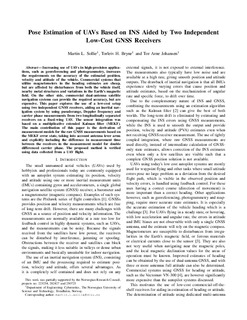Pose Estimation of UAVs Based on INS Aided by Two Independent Low-cost GNSS Receivers
Chapter
Accepted version

Åpne
Permanent lenke
http://hdl.handle.net/11250/2630389Utgivelsesdato
2019Metadata
Vis full innførselSamlinger
Originalversjon
10.1109/ICUAS.2019.8797746Sammendrag
Increasing use of UAVs in high-precision applications, such as georeferencing and photogrammetry, increases the requirements on the accuracy of the estimated position, velocity and attitude of the vehicle. Commercial systems that utilize magnetometers in the heading estimates are cheap, but are affected by disturbances from both the vehicle itself, nearby metal structures and variations in the Earth's magnetic field. On the other side, commercial dual-antenna satellite navigation systems can provide the required accuracy, but are expensive. This paper explores the use of a low-cost setup using two independent GNSS receivers, aiding an inertial navigation system by using pseudorange, Doppler frequency and carrier phase measurements from two longitudinally separated receivers on a fixed-wing UAV. The sensor integration was based on a multiplicative extended Kalman filter (MEKF). The main contribution of this paper is the derivation of measurement models for the raw GNSS measurements based on the MEKF error state, taking into account antenna lever arms and explicitly including the difference in measurement time between the receivers in the measurement model for double differenced carrier phase. The proposed method is verified using data collected from a UAV flight.